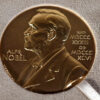EPFL mathematicians, in collaboration with Purdue University, have settled a 30-year-old question about spheres and 4-dimensional spaces. The results bring new light to the “Euler class,” one of the most powerful tools to understand complicated spaces.
For mathematicians, Euler class is one of the most powerful tools for understanding complicated spaces by cutting them into simpler pieces. It is named after Swiss mathematician Leonard Euler who was the first to consider the idea.
“Just like something as complex as DNA is ultimately made of simple atoms, it is how these simple pieces are assembled that contains the important information rather than the pieces themselves,” says Professor Nicolas Monod, who leads the Ergodic and Geometric Group Theory research unit at EPFL. His group joined forces with colleagues at Purdue University to solve an old question about spheres. The answer has been published the mathematics journal Inventiones mathematicae.
In 1958, Fields medalist John Milnor noticed a problem when trying to build spaces using only circles and two-dimensional surfaces: there was a limit on how complicated the Euler class can be in two dimensions. The observation snowballed into an entire field of research in higher dimensions, and mathematicians quickly realized that Milnor’s “complexity bound” didn’t apply for spaces in all dimensions.
Monod explains, “A question that had remained open for decades was, what about gluing spheres on 4-dimensional spaces? Is there also here a limit on how they fit together?” He continues: “Gluing spheres on 4-dimensional spaces is a particularly important construction because this is precisely how the very first ‘exotic spheres’ have been constructed.”
Classical approaches of understanding spaces have proven unable to solve this 4-dimensional question. So the EPFL mathematicians turned to the Bernoulli process, named after Swiss mathematician Jacob Bernoulli, for inspiration. The Bernoulli process, which is a model of tossing coins, was combined with the study of spheres and the Euler class to finally solve the question.
“A very curious thing happened when we set out to solve this problem,” says Monod. “If it remained unsolved for so long, it is perhaps because none of the classical methods used to understand spaces seemed to be able to crack this specific question about 4 dimensions. Instead, we turned to an unlikely source for inspiration: tossing coins.”
As a game with a 50-50 chance to guess the right side of a coin, this might seem very simple, but its simplicity is misleading. “The Bernoulli process already includes many of the advanced features of probability theory when we set out to repeat the toss more and more often,” says Monod. “In fact, the Central Limit Theorem—which is a kind of Law of Large Numbers—even tells us that this simple model can emulate many of the most complicated random phenomena of nature if we are willing to toss enough coins for long enough.”
Probability and random processes might seem not to have much to do with the the analysis of higher dimensions in space, but mathematics is as much a creative art as a science. “Earlier this year, we published the discovery that Bernoulli’s random coin games can help solve some difficult algebraic questions, very much non-random questions,” says Monod. “This has now been combined with the study of spheres and the Euler class to finally solve the old question about 4-dimensional spaces: no, there is no limit at all to the size of the Euler class for spheres in four dimensions.”
“So the coins came to the rescue of algebra and geometry, and Bernoulli visits the Euler class: indeed, mathematicians do things differently,” he concludes.
More information:
Nicolas Monod et al, Bounded and unbounded cohomology of homeomorphism and diffeomorphism groups, Inventiones mathematicae (2023). DOI: 10.1007/s00222-023-01181-w
Provided by
Ecole Polytechnique Federale de Lausanne
Citation:
Mathematicians answer questions about spheres and 4D spaces, expand scope of the Euler class (2023, February 14)



